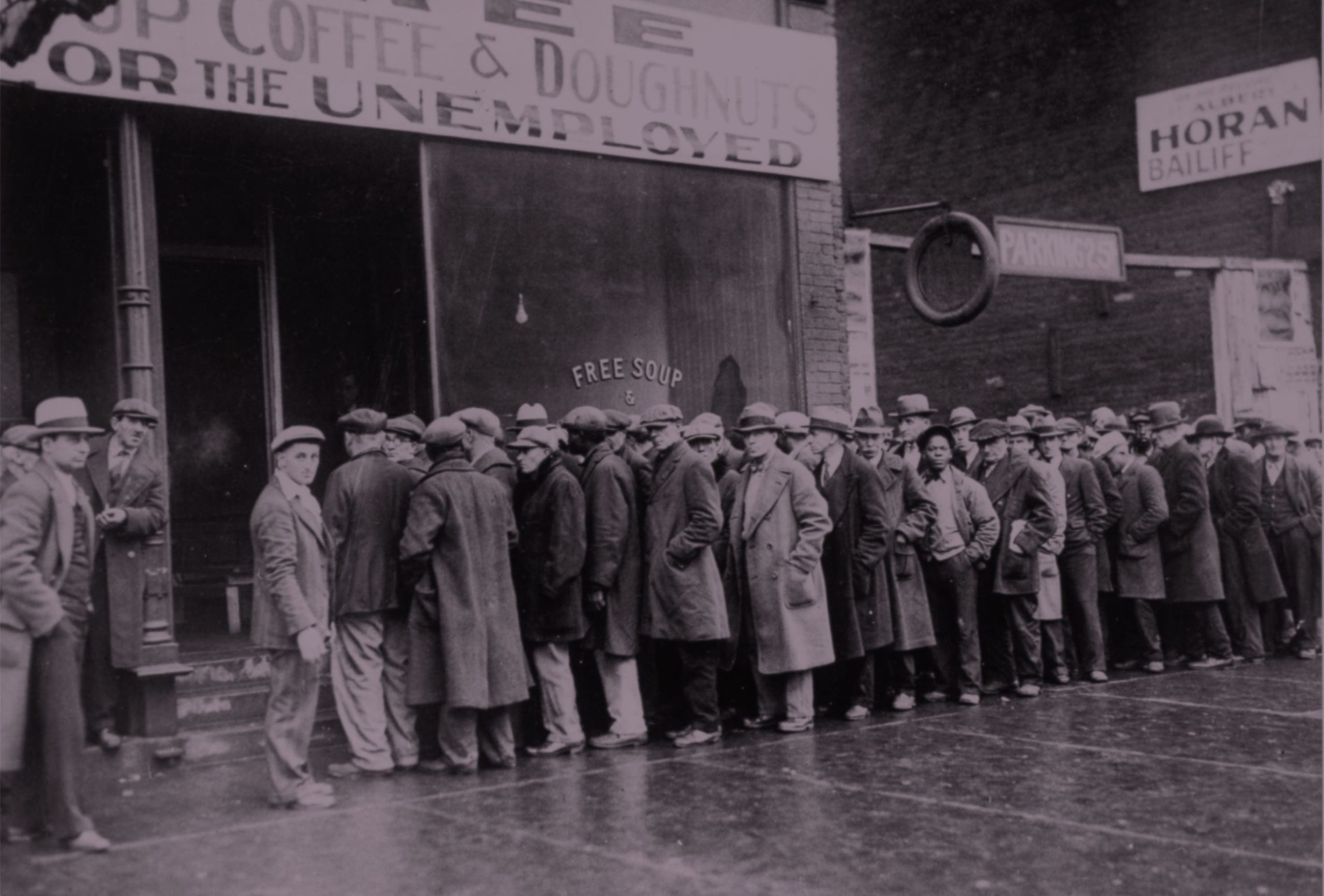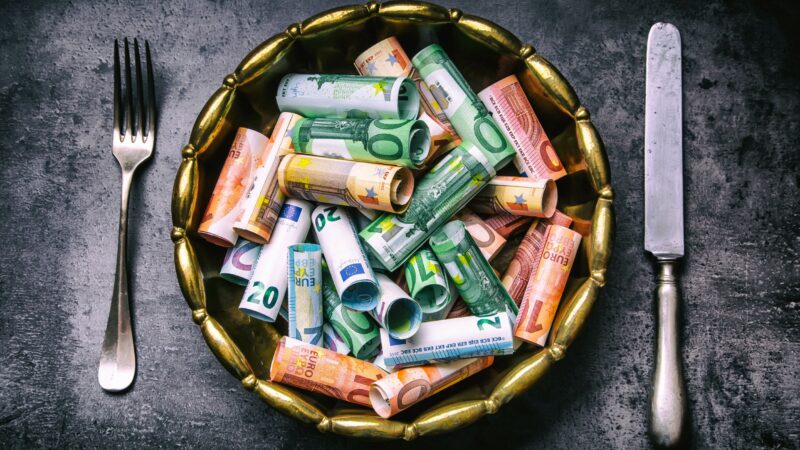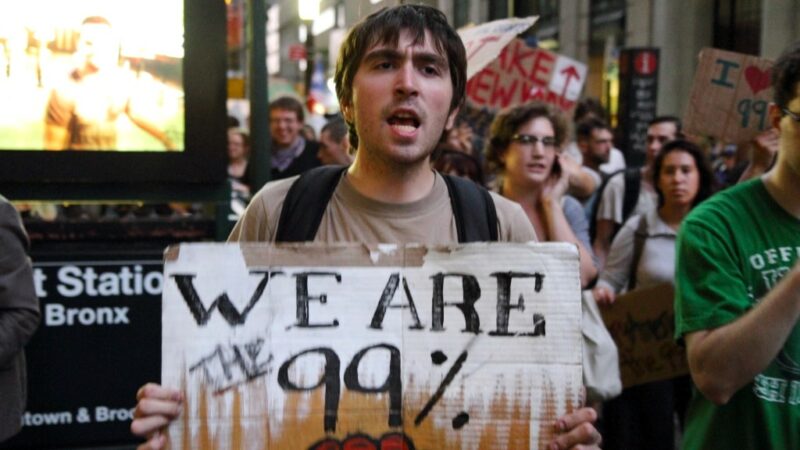 Armies of unemployed and insolvent entrepreneurs, banking crisis, and social misery: The Great Depression of the late 1920’s and 1930’s is considered the horror story of a deflationary spiral. But does it justify the current warnings of deflation?
Armies of unemployed and insolvent entrepreneurs, banking crisis, and social misery: The Great Depression of the late 1920’s and 1930’s is considered the horror story of a deflationary spiral. But does it justify the current warnings of deflation?
Preventing deflation is now one of the central monetary policy objectives of the central banks. For example, former Fed Chairman Ben Bernanke said: “Sustained deflation can be highly destructive to a modern economy and should be strongly resisted.” Bernanke considered all measures to prevent deflation as justified. Even if the key interest rate were lowered to zero, the central bank would still not exhaust its ammunition. Further sensible steps would then be to buy government bonds and pump even more central bank money into the banking system.
Philipp Bagus, Professor of Economics at the Universidad Rey Juan Carlos in Madrid, considers this fear of deflation to be unfounded. Moreover, he says that in many cases deflation is even welcome, but that the ultra-loose monetary policy that Bernanke calls for is highly detrimental, especially for the consumer. The Austrian Institute spoke to Bagus about the various forms of deflation, the deflationary spirals of the 1930’s in Germany and the 1990’s in Japan, and the current outlook for the euro zone.
You do not share the common fear of deflation. But there are different forms of deflation. Shouldn’t one differentiate between them?
Philipp Bagus: Yes, one can distinguish between them. But the fears are exaggerated of a macroeconomic problem and of falling prices being problematic in themselves.
On the one hand, there is growth deflation: we should actually be happy about falling prices due to growth. No one need fear deflation due to increased demand for money. It also always depends on how the demand for money increases. If I want more liquidity, I either save less per month or I consume less. If I reduce both equally, then there is no real effect at all, only the effect that prices fall.
Then there is credit deflation. It can only occur if there was a previous credit expansion. In this case, deflation helps to remove distortions more quickly. Of course, some people must be afraid of such deflation, namely, those who have made many bad investments or those whose jobs are affected, or those affected by other specific factors. In the medium and long term, however, it is good that the many malinvestments are more quickly eliminated by credit deflation.
One type of deflation that might still be hard to find is that caused by the state. The fact that the state introduces price controls—i.e. either sets prices below the market level or destroys money—might be considered bad deflation from an ethical standpoint.
Do you consider credit deflation painful but inevitable?
Not inevitable. You can do what they are doing today, which is to avoid it, simply by putting more and more liquidity into the market. Then you get a zombification of the economy.
But that’s even more harmful.
From the perspective of free consumers, yes. “Bad” investment means that consumers actually want something else. If I artificially maintain malinvestment by lowering interest rates to zero or to the negative, then that is not in the consumers’ interest.
The Great Depression of the 1930’s is often cited as a cautionary example of the disastrous effects of deflation. Do you see this crisis as the result of credit deflation following a previous credit expansion?
Yes, in my book In Defense of Deflation, I discussed two examples of deflation. One example is growth deflation in the U.S. after the Civil War. For more than 30 years, there were falling prices, which did not stop growth. Rather, prices were falling precisely because of growth. The second example was deflation in Germany in the 1930’s. That is exactly what happened: credit deflation. That is why I interpret the deflation policy of Heinrich Brüning (the German Chancellor from 1930 to 1932) somewhat differently and more positively than others.
That policy of his is always criticized. According to John Maynard Keynes, demand should have been stimulated. According to Milton Friedman and other representatives of monetarism, the money supply should have been increased more after the bank crash of 1929. Both points of view are widely held. What do you think about that?
The Federal Reserve cut interest rates and was expansive, but Friedman says it wasn’t expansive enough. The most important effect of the credit squeeze is to liquidate bad investments faster, thereby freeing up resources so that these resources would be available again for sustainable, new projects. The prices of the production factors fall, i.e. the costs fall, and this makes new projects profitable.
At the beginning of the 1920’s there had been a similar depression in the U.S.—only the American presidents of the time did almost nothing, and after a few months the depression was over. The Great Depression lasted so long, among other reasons, because of the protective tariffs resulting from the Smoot-Hawley Tariff Act, and the New Deal. And the way I see the situation in Germany, Hitler reaped the rewards of the upswing after Brüning had done the “hard work” beforehand, for example by cutting public service wages and limiting government spending. The adjustment was underway and almost over; then Hitler came to power.
Credit deflation need not last long.
You think the usual conclusions drawn from the Great Depression are wrong: According to you, the expansion of money supply only made things worse?
Yes. Credit deflation need not last long if markets are flexible. Then the factors of production are steered in a different direction and become productive again. The alternative is to artificially sustain the malinvestment.
In other words, it’s a short but painful operation.
Exactly.
The Great Depression surprised all economists at the time, but not the representatives of the Austrian School. Truthfully, they should have become the rising stars in the field of economics, but a few years later the opposite was the case. It seems that political leaders sought recipes for ending the crisis, but they did not find such recipes among the “Austrians” but rather with Keynes. Could this have been why the Austrian School lost influence, even though it was the only one to forecast the crisis?
That is an interesting question. Perhaps because the crisis lasted so long it wasn’t recognized that the recovery was delayed precisely because of the intervention of the New Deal and the tariffs. Thus, they thought that the state had to do more, and Keynes provided the theory for that.
But the U.S. began to recover at some point.
They didn’t emerge from the crisis until after World War II. They reached full employment before that, when they sent everyone to the front as soldiers. Then there were no longer any unemployed. But that was not a recovery from the consumer’s standpoint, because that’s not how you serve their needs: Consumers don’t want tanks, planes, or bombs; above all, they don’t want to be vanquished on the front lines.
Another recent cautionary example of deflation is Japan. Finland’s central bank chairman Olli Rehn recently defended the ultra-loose monetary policy of the European Central Bank (ECB) with reference to Japan. He argued that the deflationary spiral that Japan has been experiencing since the 1990’s must be prevented as a precautionary measure. It would therefore be better to push up inflation rather than run the risk of prolonged deflation. How do you interpret the situation in Japan?
Japan did just that: it lowered interest rates after the crash, and an expansive fiscal policy followed. The same medicine was constantly being given, and now one wonders why it is still not working. You hit a wall and it doesn’t work, then you hit the same wall again and again, harder and harder and wonder why it still doesn’t work. In Japan, companies are like a family, so they almost never lay anyone off. That makes the job market very inflexible, so they continue to make the bad investments. Companies become zombies: they can’t survive, but they can’t die either, because they can still refinance themselves through low interest rates. Resources are never released to make a sustainable upswing possible, again, because these resources are tied up in the zombies. That is the problem. It is tragic that people in Europe now want to do the same thing.
The deflationary spiral ends when the bad investments are liquidated.
But many see a deflationary spiral at work in Japan in the 1990’s: lack of demand, lower profits for investment, postponement of consumption, reduction of costs by entrepreneurs, and finally, less lending.
The deflationary spiral ends when the bad investments are liquidated. Then the prices fall of the factors of production, i.e. the costs. The difference between costs and sales prices is always important to the company. The margin must be positive. If the purchase prices fall faster than the sales prices, then the profit margin increases, and it pays to invest. You can also see this in the technology sector, where sales prices are falling and quality is rising while prices remain the same. The costs fall, and this increases the profit margin.
However, economists do not fear deflation in a certain area, such as growth deflation in the IT sector, but the simultaneous reduction of all prices, for example, through credit deflation.
In the case of loans, this leads to a redistribution from debtors to creditors. The debtors lose, the creditors win. The result: Creditors can then consume more and save more than before, and debtors can save less and consume less.
However, households that have acquired property through loans can run into serious problems. If a particularly large number are affected, the banks also get into trouble. They can then become reluctant to lend, which in turn affects the creditor side. Isn’t that a problem?
Yes, then there is commanded a kind of asset disclosure statement and massive redistribution can occur. I don’t want to deny it: If we hadn’t reacted in 2007 or 2008, we would have had a huge crisis. But there is one thing we must always bear in mind: The wealth of a society is its productive potential, such as factories, etc. This is not affected by the fact that a change of ownership is taking place. For example: a company owner is in debt and can no longer pay the debts, simply because he can no longer service the burden of nominal interest rates due to price deflation, even though his business model actually works. Now the creditor receives the company. What will it do? If the business model is truly profitable, the company will continue with it, and so it will continue to produce. The general prosperity of the economy is not affected by the change of ownership. The only losers are those who have speculated and become overindebted. Perhaps many households have done the same. On the other hand, households are also on the creditor side with their investments. It depends on the individual case whether one is a winner or a loser in the end, but if one is a loser, someone else is also a winner.
It is a misconception that in the event of price deflation no one will invest.
Do you not see dangers for the banking sector and especially for lending?
It can happen that the banking system goes bankrupt. But then new banks could emerge again, possibly creating a sustainable banking system that can then lend without any problems. On the other hand, lending may collapse because there are very high deflationary expectations. This also accelerates the fall in prices, and as soon as prices have fallen to the expected level—and provided there are no government barriers, this can happen immediately—there is no reason not to grant more new loans, especially if the adjustment happens.
Today, on the other hand, people are pumping in more and more money with negative interest rates and are surprised that little goes on after that. The distortions have remained, and everyone is overindebted. Economic growth is blocked because the bad investments are still there, and there is no opportunity to make room for new investments.
Thomas Mayer (Flossbach of Storch Research Institute) believes that a functioning economy can in fact manage without lending (see here [German]). In the U.S. it is, after all, common practice to invest saved money. This is also how most entrepreneurial success stories came about.
Yes, that is correct. Even with deflationary expectations, investments can always be financed by equity. Even a small positive return then provides an incentive to invest. I get the money back with a higher purchasing power, and I even receive interest or a yield in return.
Central banks also fear deflation because of the liquidity trap: because central banks cannot lower the key interest rate below zero, the lowest possible real interest rate remains positive in the event of deflationary expectations. This limits the possibility of creating incentives for investment via low or zero interest rates.
If real interest rates are positive due to deflationary expectations, incentives to invest may still remain. In addition to the higher purchasing power that money has after one year, a small, positive return is added. If deflation is at two percent and the positive profit margin is only one or two percent, then after one year I do not just have two percent more, but three or four percent more. It is a misconception that in the event of price deflation no one will invest. Of course, my real cash position automatically increases when prices fall, but there is still an alternative: instead of leaving 100 euros lying around, which are worth 102 euros in real terms after one year, I can also take the opportunity to invest and with a profit of five percent I will then have 105 euros nominally and 2 percent more in real terms. It is therefore not true that the incentive to invest disappears when prices fall.
In inflation the losses are less visible and more distributed.
In your view, is the fear of deflation simply motivated by self-interest, out of fear of reallocation?
That is certainly a factor. First and foremost: the biggest debtor is the state. In addition, there is what Thorsten Polleit (Ludwig von Mises Institute Deutschland) calls “collective corruption.” Given the current monetary policy, everyone has the incentive to get into debt; jobs are tied up with indebted companies that might go under in the event of deflation. In an inflexible economy, we will not be able to find a new job so quickly in a deep adjustment crisis, because we will no longer be able to pay our nominal debt; we may lose our house.
There are also public choice reasons for inflationary monetary policy: debtors are politically better organized than creditors. In the United States, around the 19th century, indebted farmers put pressure on the money press to get the press started. There is no lobby for the money lenders.
Why is there more fear of deflation than inflation, if both are symmetrical—in other words: in the case of deflation the exact opposite redistribution occurs? In the case of inflation, the debtors win and the creditors lose, but in the case of deflation it is the other way round. In inflation the losses are less visible and more distributed, because everyone loses purchasing power. We are not aware of what we could have bought without inflation. In deflation, however, the losses are more concentrated and visible. When you go bankrupt and your company loses its business or a family loses its house, it is visible to everyone. It is therefore understandable that the fear of the one is greater than the other.
All over the world, and also in Europe, we have been experiencing an ultra-loose monetary policy since the financial crisis. Some think that the ECB will continue this policy for another 20 or 30 years until everything is nationalized. Before then, more government bonds will be bought up, at some point corporate bonds, etc.
I fully agree with that. You can keep on nationalizing, and at some point you will have nationalized everything and have no more unemployed people. Under communism, all companies were zombie companies that were kept alive by the state. There is no unemployment, but you no longer produce for the needs of consumers. The state decides what and how much is produced.
Derailing monetary policy as an inconspicuous slide into a planned economy?
Yes.
You see nothing that could put a stop to this in the eurozone?
Very little. It should be in the interest of those responsible, but they are only interested in continuing the status quo. All those who have voiced even a little criticism in the Central Bank Council have been let go or have left voluntarily: see Axel Weber, Jürgen Stark, Jens Weidmann, and others. They are no longer at the helm. This is no coincidence. And if there arrives an even bigger “giant crisis,” I don’t think anything would change. Then there would actually be more incentives to continue this way. Something would have to change among the populace. People would have to take to the streets for stable money. Perhaps that could happen in the case of very large inter-European redistributions.
In his work In Defense of Deflation, Philipp Bagus first analyzes the causes and consequences of deflation. In so doing, he uncovers several myths and addresses the reasons for the widespread fear of deflation. Unlike most economists, Bagus considers deflation to be beneficial in free markets. He substantiates his theses using two historical case studies—growth deflation in the U.S. after the civil war and deflation in Germany during the Great Depression.



